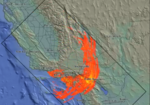ShakeMovies
From SCECpedia
Jump to navigationJump to searchSCEC researchers have produced several types of earthquake and ground motion movies and animations. SCEC Visualization groups include SDSC, PSC, ISI, USC, and SCEC Interns.
Examples of SCEC Earthquake Animations
| Thumbnail | Animation Number | Animation Description |
|---|---|---|
| Animation_1 | Puente Hills Wave Propagation Simulation. Animation showing the propagation of ground motions across the Los Angeles Basin. | |
| Animation_2 | TeraShake 2.1 Simulation with Narration - Overview of the earthquake hazards using TeraShake ground motion simulation. Animation shows both map-based views and volume-based visualizations of wavefield. | |
| Animation_3 | M8 Map View - Animation showing the M8 California earthquake rupture in a map view format. | |
| Animation_4 | M8 Perspective - Animation showing the north to south M8 California earthquake rupture, with a perspective above the fault. The amplitude of the ground motion is shown as exaggerated topography. The animation shows a seismic shock waves is formed at the rupture front, and a strong stopping pulse as the rupture ends south of the Salton Sea. | |
| Animation_5 | Shakeout Map View - ShakeOut earthquake animation showing ground motions in a map view. | |
| Animation_6 | GlyphSea Narrated Animation of M8 - Narrated animation showing GlyphSea vector visualization technique applied to M8 ground motion simulation data. | |
| Animation_7 | Shakeout_Long_Beach_Perspective - ShakeOut earthquake animation showing ground motions from the perspective of a site in Long Beach California. The animation shows the ground motions approaching from the south, then long lasting long period motions throughout the city. | |
| Animation_8 | Building Response Animation (M8 at Northridge) - Animation of response of a 18 story steel frame building to M8 ground motions in Northridge California. | |
| Animation_9 | M8 Building Response for Multiple Sites in Los Angeles - Animation showing response of multiple 18 story steel frame buildings to M8 ground motion simulation data. | |
| Animation_10 | EQ_Northridge_Site_Pacoima - Simulation showing the effects of ground motions on objects in Pacoima, about 12km from epicenter of Northridge Earthquake. The animation was created by retrieving the observed ground motions from a Pacoima strong motion station for the Northridge earthquake, then inputting these seismograms into a scene containing everyday objects, and using a physics-engine to show the results of the ground motions on the objects. | |
| Animation_11 | This video shows a small collection of four different dynamic rupture models. All the simulations are based on a postulated network of faults in the Salton Sea area, southern California. The hypocenter of these events is placed on the San Andreas fault and approximately 30km north of Bombay beach. The first seconds of the simulations show the initiation phase of the earthquake, also known as the “nucleation phase”. After this initial phase, the earthquake rupture propagates spontaneously towards the right-hand side of the screen (south-east in the map). From that point on what we observe is the interaction between different faults in this system. The interaction between the different parts of the fault system depends on the selected pre-stress conditions (“S” value). The value "S" stands for "seismic parameter", the ratio of strength excess over the expected stress drop. Low S means higher tendency for rupture than high S. For example, in model N2S-S2.0-X0.45 (bottom left panel) the cross faults are pre-stressed at a higher level (S=0.45) than the main faults (S=2.0). For that reason, the cross faults have a higher tendency to participate in the rupture process and will eventually modulate the final magnitude of this model.(Top left panel) Dynamic rupture simulation with all the participating faults pre-stressed homogeneously (no pre-stress contrast between main faults and cross-faults). [Model N2S-S2.0-X2.0]. (Bottom left panel) Dynamic rupture simulation with cross-faults pre-stressed at a higher level than the main faults. [Model N2S-S2.0-X0.45]. (Top right panel) Dynamic rupture simulation with high pre-stress level (S=0.45), shallower locking depth (15 km) and the cross-fault intersecting the main faults (segmented model). [Model N2S-S0.45-X0.45-d15km-14f]. (Bottom right panel) Dynamic rupture simulation with homogeneous high pre-stress (S=0.45) level in all the participating faults.[Model N2S-S0.45-X0.45] |










